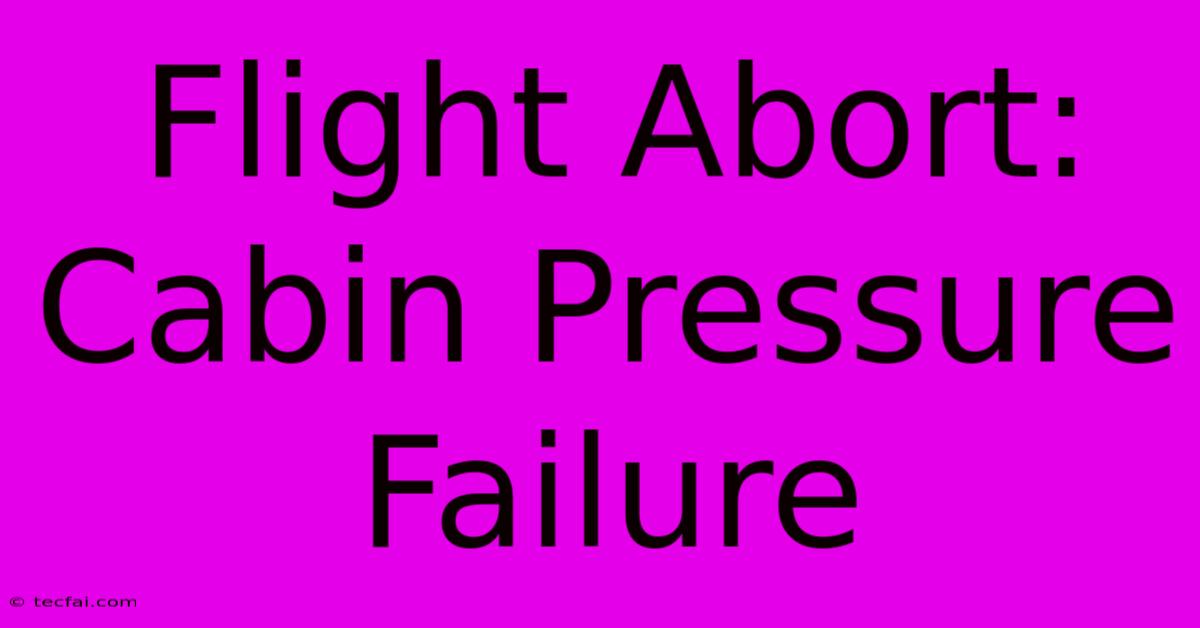Flight Abort: Cabin Pressure Failure

Discover more detailed and exciting information on our website. Click the link below to start your adventure: Visit Best Website tecfai.com. Don't miss out!
Table of Contents
Flight Abort: Cabin Pressure Failure - A Pilot's Perspective & Passenger's Guide
Air travel is statistically incredibly safe, yet the inherent risks demand constant vigilance and preparedness. One of the most serious, albeit rare, inflight emergencies is a cabin pressure failure. This article explores the causes, procedures, and what passengers should know about this critical situation.
Understanding Cabin Pressurization
Before delving into emergencies, understanding the normal operation is crucial. Aircraft cabins are pressurized to simulate the atmospheric pressure at around 8,000 feet, even at cruising altitudes of 30,000 feet or more. This is done to ensure passenger and crew comfort and well-being, preventing hypoxia (lack of oxygen) and other altitude-related illnesses. The pressurization system involves a complex network of components, including air compressors, valves, and pressure regulators.
Causes of Cabin Pressure Failure
A failure in this system can stem from several sources, often categorized as:
-
Structural Damage: This is a less frequent cause, often resulting from a significant event like severe turbulence or a collision with birds or other objects. Such damage might compromise the structural integrity of the fuselage, causing depressurization.
-
System Malfunction: More commonly, cabin pressure failure arises from malfunctions within the pressurization system itself. This might involve a failure in the air compressors, leaks in the system's ducting, or problems with the pressure regulators or valves. Regular maintenance is critical to minimize these risks.
-
Other Factors: Rarely, factors such as explosive decompression (sudden and catastrophic failure) due to a significant breach in the aircraft's structure can occur.
Pilot Procedures During Cabin Pressure Failure
Upon detection of a cabin pressure failure, the pilot's actions are swift and decisive. Their training emphasizes:
-
Immediate Descent: The primary objective is to descend rapidly to a lower altitude where the ambient pressure is closer to that of the cabin, mitigating the effects of hypoxia. This descent will be rapid, but controlled.
-
Oxygen Masks: Pilots and crew will deploy oxygen masks and ensure passengers receive instructions on their use.
-
Emergency Procedures: Standard operating procedures (SOPs) dictate further actions, which might include contacting air traffic control (ATC) to declare an emergency, coordinating with medical personnel on the ground, and preparing for an emergency landing.
Passenger Actions During a Cabin Pressure Failure
The experience of a cabin pressure failure can be alarming, but understanding the proper response is crucial:
-
Listen to Crew Instructions: Follow all instructions from the cabin crew precisely. They are trained to handle such situations and their guidance is paramount.
-
Oxygen Masks: If oxygen masks deploy, put yours on immediately, even if you feel fine. Hypoxia can set in gradually and without immediate symptoms. Ensure children's masks are properly secured.
-
Remain Calm: Panic will only exacerbate the situation. Try to remain calm and assist others if possible, especially vulnerable individuals.
-
Secure Loose Items: Secure any loose items that could become projectiles during a rapid descent.
-
Prepare for Landing: Be prepared for a possibly bumpy and abrupt landing as the pilot prioritizes a safe return to the ground.
The Aftermath
Following a successful emergency landing, passengers will likely undergo medical evaluation. Investigations into the cause of the pressure failure will be conducted rigorously by the airline and aviation authorities. Data recorders will provide vital information for understanding what transpired.
Conclusion:
While cabin pressure failure is a rare event, understanding the potential causes, procedures, and passenger actions is vital for both pilots and passengers. The robustness of safety protocols and the rigorous training pilots undergo significantly mitigate the risks associated with such occurrences. Remember, remaining calm and adhering to crew instructions are key to safe passage through this type of inflight emergency.

Thank you for visiting our website wich cover about Flight Abort: Cabin Pressure Failure. We hope the information provided has been useful to you. Feel free to contact us if you have any questions or need further assistance. See you next time and dont miss to bookmark.
Featured Posts
-
Brighton And Southampton 1 1 Gelykop
Nov 30, 2024
-
Jihadists Advance On Aleppo City
Nov 30, 2024
-
Big Data Transforming Industry Decisions
Nov 30, 2024
-
Russia Syria Hit Aleppo Insurgents
Nov 30, 2024
-
Desisyon Sa Pondo Ng Ovp Malapit Na
Nov 30, 2024
